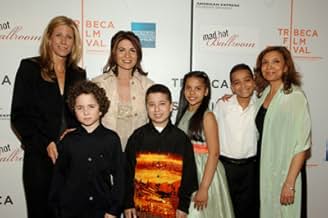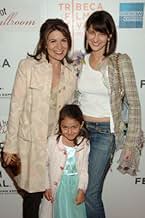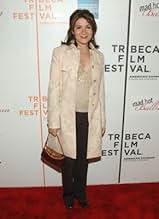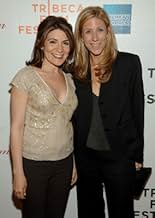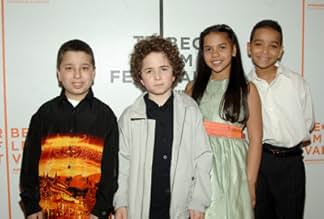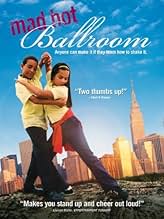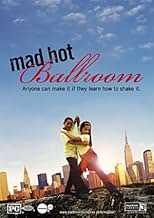IMDb रेटिंग
7.4/10
3.6 हज़ार
आपकी रेटिंग
अपनी भाषा में प्लॉट जोड़ेंThe students of several New York City elementary schools learn ballroom dancing and compete in a city wide dance competition.The students of several New York City elementary schools learn ballroom dancing and compete in a city wide dance competition.The students of several New York City elementary schools learn ballroom dancing and compete in a city wide dance competition.
- पुरस्कार
- 8 जीत और कुल 10 नामांकन
फ़ीचर्ड समीक्षाएं
"Mad Hot Ballroom"is a valentine to New York City public school kids.
As a parent of such kids, I immediately fell in love with the film and that was even before three-quarters through "some school in Queens" in the ballroom dancing competition turned out to be my neighborhood school five blocks away (though my younger son only attended it for three kindergarten days 16 years ago before I switched him to a school where he wasn't the only kid in his class speaking English) -- no wonder the film has played at my neighborhood art house for six weeks.
In a school system starved for arts education, particularly music and dance--whereas in my NJ suburban school our winter gym classes were traditional square dancing, my older son's school only had an annual dance festival consisting of a couple of mostly simplified folk dance routines-- the film also salutes the young and the experienced, dedicated teachers and principals who get swept up in their students' progress and the competition (though their self-serving claims of how the dancing transformed specific "at-risk" kids has to be taken with some grains of salt as we see only tiny evocations and parent reactions to back-up such dramatic changes).
What the film does beautifully is demonstrate the glorious diversity of our public schools, by race--with all shades of white, black, Asian, and Hispanic-- class, national origin and language, with the schools serving now as the melting pot cauldron they did for immigrants and native-born kids a hundred years ago. The specific ballroom dances selected for the competition that have entered the American popular culture pantheon for social occasions dovetail nicely with the kids' sense of national pride as well -- the merengue from the Dominican Republic; the rhumba from Cuba; the pop-based foxtrot; and swing that grew out of African-American traditions. The sexualized aspect of moving their bodies "downstairs" is certainly far less than they get from MTV and is presented as a formal choreography.
While the kids comfortably express their thoughts in front of the cameras --they are just at the age before embarrassment and insecurities take over--about the opposite sex, their families, their futures and their neighborhoods, most of the social and political issues about public education are inferred indirectly. At the Washington Heights school where most of the kids are from the Dominican Republic, the case for bilingual education and the importance of having role models from the same culture is reinforced as the principal and the male dance teacher move easily back and forth between Spanish and English like the kids, which is particularly helpful for drawing out more recent immigrants (or because, as a friend of mine who teaches in the neighborhood says local tradition has the kids going back and forth to the island frequently).
The film spends most of its time in this Upper Manhattan neighborhood (pulling your heart strings to root for them over all the other teams), from the visuals of the housing, families, merchants, statistics about poverty and casual commentary on drug dealing, much more than the school in Bensonhurst, Brooklyn that we quickly have to perceive as working class, and Tribeca in Lower Manhattan, with its scarily articulate middle class kids (though we are told for some sympathy that the program started in that school partly as a morale booster after they were finally able to return to their school post-9/11 and we see them move on to band practice). All three schools, as well as my Forest Hills, Queens school which is included even more superficially, are shown as racially diverse. The lack of more context would probably be confusing for non-New Yorkers or long-time expatriates who aren't up on the current diversity of the city's neighborhoods.
In addition to the usual bromides about discipline and etiquette as a justification for the program, the class and gender issues about dance education as an expression for talent and opening up horizons vs. as a competition are dealt with very well. As the parent of two very active public school debaters, which also is structured as individual achievement within a mutually reinforcing team format, I do see that competition keeps boys involved in a non-athletic activity focused.
For all the sturm und drang from the losers ("We did everything we were told to do!") and their emotional teacher, it is useful that the film carries through to the finals, as it is striking when we see the best kids, to let talent and hard work shine (we saw the winners put in hours of extra after-school practice time). While there's another fleeting touching moment as we see them come out of the subway to walk past Ground Zero to get to the World Financial Center, the filmmakers wisely resist interviewing the noted judges there, including choreographers Ann Reinking and Graciela Daniele, for what would probably be platitudes.
Stay through the final credits and cute song, as not only do the filmmakers graciously acknowledge everyone involved in the program and on screen, the kids' discussions charmingly continue.
As a parent of such kids, I immediately fell in love with the film and that was even before three-quarters through "some school in Queens" in the ballroom dancing competition turned out to be my neighborhood school five blocks away (though my younger son only attended it for three kindergarten days 16 years ago before I switched him to a school where he wasn't the only kid in his class speaking English) -- no wonder the film has played at my neighborhood art house for six weeks.
In a school system starved for arts education, particularly music and dance--whereas in my NJ suburban school our winter gym classes were traditional square dancing, my older son's school only had an annual dance festival consisting of a couple of mostly simplified folk dance routines-- the film also salutes the young and the experienced, dedicated teachers and principals who get swept up in their students' progress and the competition (though their self-serving claims of how the dancing transformed specific "at-risk" kids has to be taken with some grains of salt as we see only tiny evocations and parent reactions to back-up such dramatic changes).
What the film does beautifully is demonstrate the glorious diversity of our public schools, by race--with all shades of white, black, Asian, and Hispanic-- class, national origin and language, with the schools serving now as the melting pot cauldron they did for immigrants and native-born kids a hundred years ago. The specific ballroom dances selected for the competition that have entered the American popular culture pantheon for social occasions dovetail nicely with the kids' sense of national pride as well -- the merengue from the Dominican Republic; the rhumba from Cuba; the pop-based foxtrot; and swing that grew out of African-American traditions. The sexualized aspect of moving their bodies "downstairs" is certainly far less than they get from MTV and is presented as a formal choreography.
While the kids comfortably express their thoughts in front of the cameras --they are just at the age before embarrassment and insecurities take over--about the opposite sex, their families, their futures and their neighborhoods, most of the social and political issues about public education are inferred indirectly. At the Washington Heights school where most of the kids are from the Dominican Republic, the case for bilingual education and the importance of having role models from the same culture is reinforced as the principal and the male dance teacher move easily back and forth between Spanish and English like the kids, which is particularly helpful for drawing out more recent immigrants (or because, as a friend of mine who teaches in the neighborhood says local tradition has the kids going back and forth to the island frequently).
The film spends most of its time in this Upper Manhattan neighborhood (pulling your heart strings to root for them over all the other teams), from the visuals of the housing, families, merchants, statistics about poverty and casual commentary on drug dealing, much more than the school in Bensonhurst, Brooklyn that we quickly have to perceive as working class, and Tribeca in Lower Manhattan, with its scarily articulate middle class kids (though we are told for some sympathy that the program started in that school partly as a morale booster after they were finally able to return to their school post-9/11 and we see them move on to band practice). All three schools, as well as my Forest Hills, Queens school which is included even more superficially, are shown as racially diverse. The lack of more context would probably be confusing for non-New Yorkers or long-time expatriates who aren't up on the current diversity of the city's neighborhoods.
In addition to the usual bromides about discipline and etiquette as a justification for the program, the class and gender issues about dance education as an expression for talent and opening up horizons vs. as a competition are dealt with very well. As the parent of two very active public school debaters, which also is structured as individual achievement within a mutually reinforcing team format, I do see that competition keeps boys involved in a non-athletic activity focused.
For all the sturm und drang from the losers ("We did everything we were told to do!") and their emotional teacher, it is useful that the film carries through to the finals, as it is striking when we see the best kids, to let talent and hard work shine (we saw the winners put in hours of extra after-school practice time). While there's another fleeting touching moment as we see them come out of the subway to walk past Ground Zero to get to the World Financial Center, the filmmakers wisely resist interviewing the noted judges there, including choreographers Ann Reinking and Graciela Daniele, for what would probably be platitudes.
Stay through the final credits and cute song, as not only do the filmmakers graciously acknowledge everyone involved in the program and on screen, the kids' discussions charmingly continue.
It's been two glorious weeks for us award-winning teachers. Last week I reviewed the documentary Rock School, a raucous romp with teens from Philly grooving Zappa all the way to Germany. This week's Mad Hot Ballroom shows the NYC public schools competing for top honors in ballroom dancing, a required course that lets students and teachers, supplied by the American Ballroom Theater, strut their best stuff in the tango, rumba, meringue, and foxtrot.
Like last year's Spellbound, everyone gets to show competitive spirit with low-level anguish at losing and testosterone-fueled joy at winning. The strength of Ballroom is the enthusiasm of teachers who have little to gain but the biggest prize of allthe success of their charges. Fairly absent is the dominance of stage-door parents in the spelling competition. Ballroom better captures the harmony that pervades a group project where the human body gracefully expresses its glory and young people experience perhaps for the first time the wonder of collective activity that ties them to peers and teachers and effaces their natural youthful loneliness, delinquent temptations, and fear of losing.
Some will criticize Ballroom for showing too many contestants and thereby losing the intimacy documentaries thrive on. Yet, the eventual winners stand out from the first moment they appear, almost exonerating director Agrelo from the intimacy requirement; also, that communal experience is better explained through the roving camera and long shots of their dancing. Although Ballroom may be too long by as much as 15 minutes, I admit I would have liked to linger more with some of the children to see how their lives have been changed by the experience; Agrelo lets the voice over take care of a couple of histories.
Cinematographer Claudia Raschke's camera, held level with the children's faces, does its own winning dance with us as viewing partners. You'll want to put on your dancing shoes after this film.
Like last year's Spellbound, everyone gets to show competitive spirit with low-level anguish at losing and testosterone-fueled joy at winning. The strength of Ballroom is the enthusiasm of teachers who have little to gain but the biggest prize of allthe success of their charges. Fairly absent is the dominance of stage-door parents in the spelling competition. Ballroom better captures the harmony that pervades a group project where the human body gracefully expresses its glory and young people experience perhaps for the first time the wonder of collective activity that ties them to peers and teachers and effaces their natural youthful loneliness, delinquent temptations, and fear of losing.
Some will criticize Ballroom for showing too many contestants and thereby losing the intimacy documentaries thrive on. Yet, the eventual winners stand out from the first moment they appear, almost exonerating director Agrelo from the intimacy requirement; also, that communal experience is better explained through the roving camera and long shots of their dancing. Although Ballroom may be too long by as much as 15 minutes, I admit I would have liked to linger more with some of the children to see how their lives have been changed by the experience; Agrelo lets the voice over take care of a couple of histories.
Cinematographer Claudia Raschke's camera, held level with the children's faces, does its own winning dance with us as viewing partners. You'll want to put on your dancing shoes after this film.
10zzanita
You can't help but smile throughout this movie... the filmmakers have beautifully showcased an amazing group of children and teachers, along with the struggles and triumphs in the competitive world of ballroom dancing. It's loads of fun for all ages...
In this age of reality television, I believe audiences will truly embrace this moving (yet funny!) documentary. It follows 4th & 5th graders at three public schools in New York City that have ballroom dance as part of their curriculum. We watch these diverse groups of kids learn the tango, merengue, rumba, foxtrot and swing and ultimately blossom into talented dancers while becoming little "ladies and gentlemen."
In this age of reality television, I believe audiences will truly embrace this moving (yet funny!) documentary. It follows 4th & 5th graders at three public schools in New York City that have ballroom dance as part of their curriculum. We watch these diverse groups of kids learn the tango, merengue, rumba, foxtrot and swing and ultimately blossom into talented dancers while becoming little "ladies and gentlemen."
10Ed-90
At first, I told my wife I didn't want to go. I thought it was yet another movie of McDonalds generation 11-year-olds, snotty and attitudinal, populated with stupid, bumbling adults trying to please them. I was very, very wrong. It was one of the best movies I've seen in years. It had meaning, warmth, humor, pathos--you name it. It had real adults, and real kids. Real teachers who were not afraid to be clear, loud and firm with kids, but with a great deal of love for them--and vice-versa. Plus, it makes you fall in love with NYC. I want to see the film again, and I can't recommend it enough. Hey, it's appropriate for everyone, too. (By the way, look for the lady who played Oliver Warbucks' assistant Grace in the movie "Annie"--she's a real dancer and one of the judges at the end.) In sum: don't miss this magic film.
This is a heart warming and amusing documentary about a ballroom dancing competition between 11 year old students at several New York public schools where ballroom dancing is taught. The kids are taught to dance the merengue, tango, foxtrot and other steps. To merely say it was cute is an understatement.
It begins as the kids start to learn to dance, at first sometimes awkward and bashful, but by the end of the course the kids are transformed into "ladies and gentlemen" (as the teachers refer to them), miniature versions of accomplished ballroom dancers. The children take on many of the aspects of professional adult dancers, moving to the beat of the music, always smiling and making eye contact with their partners while they dance like pros.
This film is likely to cause parents who see it to want their kids to learn too. It will not be surprising if ballroom dancing courses begin to spread in schools through the country.
It begins as the kids start to learn to dance, at first sometimes awkward and bashful, but by the end of the course the kids are transformed into "ladies and gentlemen" (as the teachers refer to them), miniature versions of accomplished ballroom dancers. The children take on many of the aspects of professional adult dancers, moving to the beat of the music, always smiling and making eye contact with their partners while they dance like pros.
This film is likely to cause parents who see it to want their kids to learn too. It will not be surprising if ballroom dancing courses begin to spread in schools through the country.
क्या आपको पता है
- ट्रिवियाThe three schools that the film follows are: PS 150 from the affluent Tribeca area; PS 112 from the primarily Italian and Asian area of Bensonhurst; and PS 115 from Washington Heights, a Dominican neighborhood where over 97% of the residents live below the poverty line.
- भाव
White chubby kid: My religion does not allow me to dance, and Mouhamed's does not allow him to dance either, so we have really enjoyed being DJs.
Mouhamed: Everybody has been very nice to me, although... I am... from another...
[hesitates]
Mouhamed: country.
- क्रेज़ी क्रेडिटSome of the children add their observations about life in film clips during the credits.
- कनेक्शनFeatured in Late Night with Conan O'Brien: Al Franken/Fountains of Wayne (2005)
- साउंडट्रैकFEVER
by Peggy Lee
टॉप पसंद
रेटिंग देने के लिए साइन-इन करें और वैयक्तिकृत सुझावों के लिए वॉचलिस्ट करें
- How long is Mad Hot Ballroom?Alexa द्वारा संचालित
- Chapters, scenes and acts
विवरण
- रिलीज़ की तारीख़
- कंट्री ऑफ़ ओरिजिन
- भाषाएं
- इस रूप में भी जाना जाता है
- Сумасшедшие бальные танцы
- फ़िल्माने की जगहें
- उत्पादन कंपनियां
- IMDbPro पर और कंपनी क्रेडिट देखें
बॉक्स ऑफ़िस
- US और कनाडा में सकल
- $81,17,961
- US और कनाडा में पहले सप्ताह में कुल कमाई
- $45,348
- 15 मई 2005
- दुनिया भर में सकल
- $91,04,327
- चलने की अवधि1 घंटा 45 मिनट
- रंग
- ध्वनि मिश्रण
- पक्ष अनुपात
- 1.85 : 1
इस पेज में योगदान दें
किसी बदलाव का सुझाव दें या अनुपलब्ध कॉन्टेंट जोड़ें




